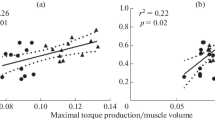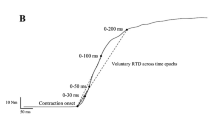Abstract
It has been reported that there is a relationship between power output and fibre type distribution in mixed muscle. The strength of this relationship is greater in the range of 3–8 rad · s−1 during knee extension compared to slower or faster angular knee extensor speeds. A mathematical model of the force: velocity properties of muscle with various combinations of fast- and slow-twitch fibres may provide insight into why specific velocities may give better predictions of fibre type distribution. In this paper, a mathematical model of the force: velocity relationship for mixed muscle is presented. This model demonstrates that peak power and optimal velocity should be predictive of fibre distribution and that the greatest fibre type discrimination in human knee extensor muscles should occur with measurement of power output at an angular velocity just greater than 7 rad · s−1. Measurements of torque: angular velocity relationships for knee extension on an isokinetic dynamometer and fibre type distribution in biopsies of vastus lateralis muscles were made on 31 subjects. Peak power and optimal velocity were determined in three ways: (1) direct measurement, (2) linear regression, and (3) fitting to the Hill equation. Estimation of peak power and optimal velocity using the Hill equation gave the best correlation with fibre type distribution (r > 0.5 for peak power or optimal velocity and percentage of fast-twitch fibres). The results of this study confirm that prediction of fibre type distribution is facilitated by measurement of peak power at optimal velocity and that fitting of the data to the Hill equation is a suitable method for evaluation of these parameters.
Similar content being viewed by others
References
Bergstrom J (1962) Muscle electrolytes in man. Scand J Clin Lab Invest 14 [Suppl 68]:1–110
Brooke MH, Kaiser KK (1970) Muscle fiber types: how many and what kind? Arch Neurol 23:369–379
Brooks SV, Faulkner JA (1991) Forces and powers of slow and fast skeletal muscles in mice during repeated contractions. J Physiol (Lond) 436:701–710
Coyle EF, Costill DL, Lesmes GR (1979) Leg extension power and muscle fiber composition. Med Sci Sports Exerc 11:12–15
Coyle EF, Feiring DC, Rotkis TC, et al (1981) Specificity of power improvements through slow and fast isokinetic training. J Appl Physiol 51:1437–1442
Edman KAP (1979) The velocity of unloaded shortening and its relation to sarcomere length and isometric force in vertebrate muscle fibers. J Physiol (Lond) 291:143–159
Faulkner JA, Claflin DR, McCully KK (1986) Power output of fast and slow fibers from human skeletal muscles. In: Jones NL, McCartney N, McComas AJ (eds) Human muscle power. Human Kinetics, Champaign, Ill., pp 81–90
Fitts RH, Costill DL, Gardetto PR (1989) Effect of swim exercise training on human muscle fiber function. J Appl Physiol 66:465–475
Froese EA, Houston ME (1985) Torque-velocity characteristics and muscle fiber type in human vastus lateralis. J Appl Physiol 59:309–314
Gregor RJ, Edgerton VR, Perrine JJ, Campion DS, DeBus C (1979) Torque-velocity relationships and muscle fiber composition in elite female athletes. J Appl Physiol 47:388–392
Hill AV (1938) The heat of shortening and the dynamic constants of muscle. Proc R Soc London Ser B 126:136–195
Hill AV (1970) First and last experiments in muscle mechanics. Cambridge University Press, London
Houston ME, Norman RW, Froese EA (1988) Mechanical measures during maximal velocity knee extension exercise and their relation to fibre composition of the human vastus lateralis muscle. Eur J Appl Physiol 58:1–7
Ikai M, Fukunaga T (1968) Calculation of muscle strength per unit cross-sectional area of a human muscle by means of ultrasonic measurements. Int Z Angew Physiol 26:26–32
Ivy JL, Withers RT, Brose G, Maxwell BD, Costill DL (1981) Isokinetic contractile properties of the quadriceps with relation to fiber type. Eur J Appl Physiol 47:247–255
Kojima T (1991) Force-velocity relationship of human elbow flexors in voluntary isotonic contraction under heavy loads. Int J Sports Med 12:203–213
Lexell J, Taylor CC (1991) Variability in muscle fibre areas in whole human quadriceps muscle: effects of increasing age. J Anat 174:239–249
Lexell J, Henriksson-Larsen K, Sjostrom M (1983) Distribution of different fibre types in human skeletal muscle. 2. A study of cross-sections of whole m. vastis lateralis. Acta Physiol Scand 117:115–122
Perrine JJ, Edgerton VR (1978) Muscle force-velocity and power-velocity relationships under isokinetic loading. Med Sci Sports Exerc 10:159–166
Ruff RL, Whittlesey D (1991) Ca-, Sr-tension relationships and contraction velocities of human muscle fibers. Muscle Nerve 14:1219–1226
Thorstensson A, Grimby G, Karlsson J (1976) Force-velocity relations and fiber composition in human knee extensor muscles. J Appl Physiol 40:12–16
Thorstensson A, Larsson L, Tesch P, Karlsson J (1977) Muscle strength and fiber composition in athletes and sedentary men. Med Sci Sports Exerc 9:26–30
Tihanyi J, Apor P, Fekete G (1982) Force-velocity-power characteristics and fiber composition in human knee extensor muscles. Eur J Appl Physiol 48:331–343
Vandewalle H, Peres G, Heller J, Panel J, Monod H (1987) Force-velocity relationship and maximal power on a cycle ergometer: correlation with the height of a vertical jump. Eur J Appl Physiol 56:650–656
Yates JW, Kamon E (1983) A comparison of peak and constant angle torque-velocity curves in fast and slow-twitch populations. Eur J Appl Physiol 51:67–74
Author information
Authors and Affiliations
Rights and permissions
About this article
Cite this article
MacIntosh, B.R., Herzog, W., Suter, E. et al. Human skeletal muscle fibre types and force: velocity properties. Europ. J. Appl. Physiol. 67, 499–506 (1993). https://doi.org/10.1007/BF00241645
Accepted:
Issue Date:
DOI: https://doi.org/10.1007/BF00241645




